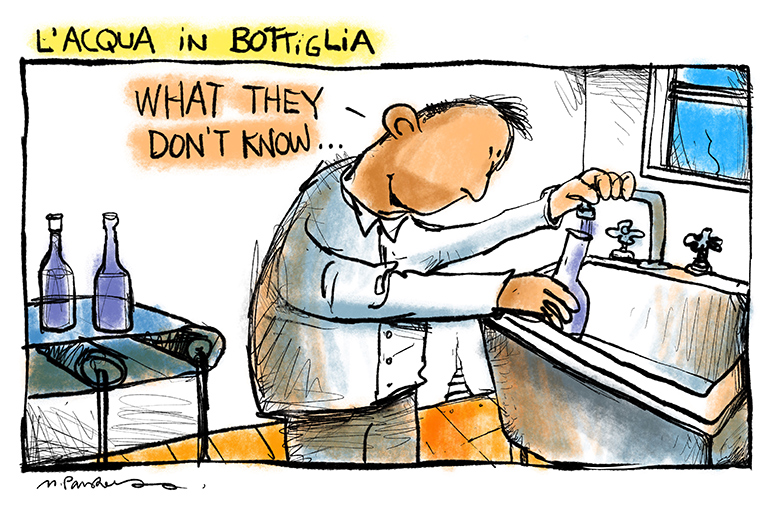Me and the Bottle: Rainy Day Thoughts on Pellegrino and Bubbly Water

I sit at my kitchen table in East Hampton with an hour to kill, slowly drinking a bottle of Pellegrino. A cold rain is thundering down on the roof outside. I read the Pellegrino label. There are two, a small one on the neck and a large one on the belly.
The larger one says it is bottled at the source, is sparking natural mineral water, and that source is in Bergamo, Italy.
The small one features a picture of a very old three-story factory building with the date 1899 beneath it. The building has two bell towers. One can imagine the workmen in the factory, bottling away. Maybe there is a bubbling gusher coming out of a waterfall to deal with. Maybe it’s water from a stream. Don’t know. What I do know is that this bottle came through the Mediterranean and out across the Atlantic in a group of six in a pack, probably aboard a freighter. The engines aboard some such freighters are powered by a diesel fuel of such low grade I’ve read it cannot permissibly be used on land because of all the pollution it gives off.
I take out my laptop. I am going to track that building down. I wonder, is it still in use?
What comes up are architect sketches of what will be an absolutely enormous Pellegrino factory to be built. Undoubtedly it will be built one day.
The factory runs along the shore of the river.
Along the way, some percentage of it is diverted into the factory to become Pellegrino water. There are 10 assembly lines that run for the full length of the factory for a quarter-mile parallel to the river. Each of the lines operates 24 hours a day, with the water getting quality tested, filtered, heated, cooled, carbonated, bottled, capped, labeled, boxed, put onto trucks and taken to a dock where the boxes are loaded into containers that are put on ships in enough quantities to satisfy the demands of thirsty people all around the world.
You know, early on there was Perrier. Perrier, bottled in France, had this market cornered. But now Pellegrino has carved out a big share of the market. Why did Perrier let that happen? Perrier river water not fast enough? Owners of Perrier not able to keep up with demand? Don’t know.
My cell phone screen shows a chart of all the minerals in Pellegrino. Magnesium, calcium, sodium and more. It also says it has a higher pH and is thus less acidic than Perrier, but only slightly.
Now here we are in Bergamo, Italy, where the bells in the two towers used to clang when there was a shift change and the workers would march in enthusiastically or go home exhausted or whatever, but now there’s no bell towers. So maybe a steam whistle sounds. Or a buzzer buzzes.
And yes, they were proud of the bell towers, but then progress marches on.
And that’s what I learned looking at a bottle of Pellegrino water sitting at my kitchen table during a rainstorm the other day.
But now, this day, I have another thought. In getting to look at the Pellegrino factory, I also looked at photographs of the very charming old walled city of Bergamo, where it is made. The city goes back 2,000 years. There are city squares, churches, markets, cobblestone streets and important Renaissance buildings. The population today is 600,000. And probably a whole lot of them are working for Pellegrino.
And then it hits me. The drawing on the bottle may not be of the first Pellegrino factory in 1899 at all. It might be of a historic Catholic church built in the 13th century where, out back somebody after a sermon in 1899 drank from that excellent river and thought, you know, if we add a little carbonation…What do you think, your holiness?
* * *
You know, I think when you compare today’s fast paced 24-hour bottling shifts where workers jump to the tooting of the lunch whistle versus the old days where life was slower, the work still got done and Sunday was a day of rest, well, which was better?
The old days, of course. Clear skies, sunshine, simple life, hymns to sing. It’s been all downhill since then.



